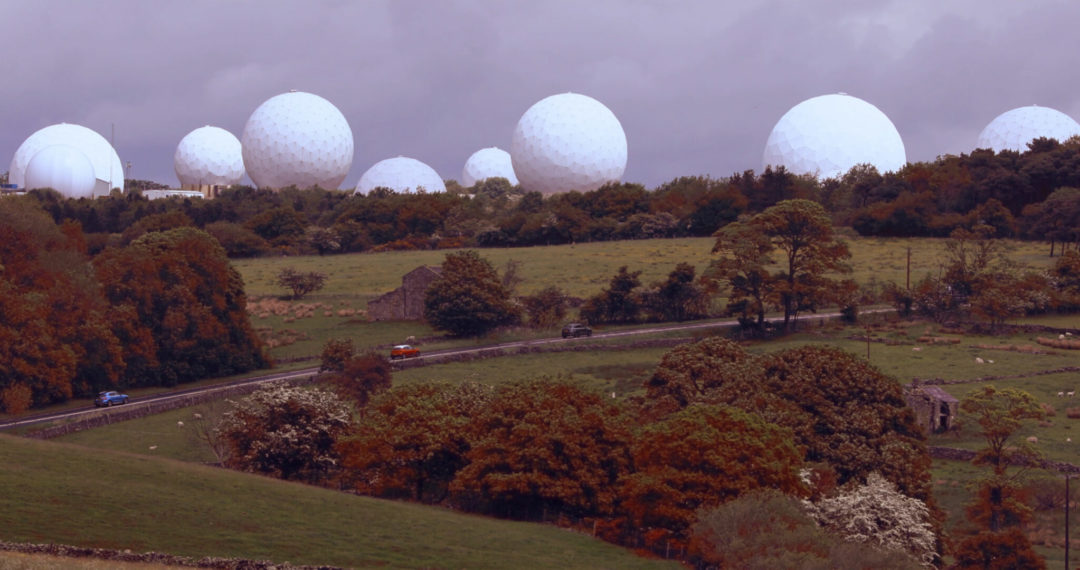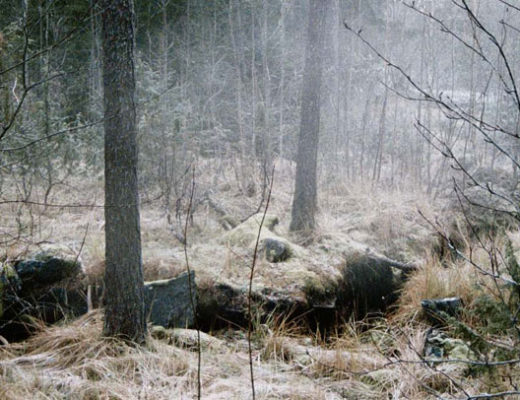Andrew Black’s On Clogger Lane is a sedimentary sort of film: built up through layers and time. Slow fades transpose one perspective over another, imbuing the work with a rich sense of the rural weird. Given that the film digs about in the Washburn Valley in Yorkshire, a place of shale and fossil-rich sandstone, this feels appropriate. In his attunement to the geological, however, Black does not succumb to the kind of political amnesia all too common with ‘deep time’ perspectives. On Clogger Lane is about people as much as it is about place. And by ‘people’ I mean not only community and cooperation but also conflict. The film maps multiple human presences – from cup and ring marks to wind turbines, dilapidated mills, lost villages, military bases, quarries, mines, walls and fences – but, in holding all these layers together, it manages not to flatten them into one generalised ‘human’ trace. It remains at all times sensitive to the specific.
The film’s conceptual starting point is the damning and flooding of the Washburn Valley in the late nineteenth century in order to create four reservoirs to supply drinking water to Leeds. In response to the erasure involved in such a large-scale sinking, imposed in the name of industry/profit/progress, On Clogger Lane enacts a bubbling to the surface of places and people and stories and the connections between them. Threading oral histories with archival film and Black’s own footage, the work is structured as a series of chapters. Each is delineated by a kind of title page that channels medieval illuminated manuscripts via DIY zine culture. Over atmospheric black-and-white drawings by artist and musician John Godbert (perhaps best known for his cover artwork for The Fall’s 1979 album Live at the Witch Trials) are a series of red handwritten notes naming various things, narratives or ideas “at the bottom of the reservoir”. One reads: “Time stands still at the bottom of the reservoir.”
In sketching a continually contested landscape of extraction and resistance, the film raises some familiar issues – enclosure and accusations of witchcraft, child labour and the industrial revolution, suppression of folk knowledge practices etc – but these are imbued with complexity and emotional power through their rooted local specificity. Unmarked graves turn out to contain the bodies of over a hundred adolescents, bearing a wide range of injuries from working in the local mills. With parents likely in the workhouse, we’re told, they were brought from London and Hull, and indentured until the age of 21 when they may have been able to go free “if they weren’t too physically damaged”. Similarly, there is something peculiarly horrifying in the account given by the manager of a quarry describing finding networks of tiny underground passages worked by lead miners long before machinery turned up to extract limestone.
The film connects these histories with more recent narratives of occupation and resistance. Looming over the landscape is a series of large white ‘golf balls’, part of Menwith Hill, a military communications and surveillance facility run by the US Department of Defense. Resisting this uncanny presence and its violent, imperialist purposes are Sylvia Boyes, Anne Lee and Lindis Percy, three seasoned peace protesters whose shared energy and morality give the film its heart. “Is the earth really ours to do what we want with?” asks Percy near the end. “Surely it’s held in trust? We hold it in trust for future generations.” Together, Boyes, Lee and Percy personify a spirit of resistance, seeing protest not only as a necessary personal risk but also as community-building and joyful.
Music and sound are vital to the film’s success. The experimental score includes improvised music by Vibracathedral Orchestra. Gongs and thrumming drone noises create a sense of imminent threat, while a series of old songs – medieval, Elizabethan – evoke a blurry historicism. Rather brilliantly, these have been rendered with synthesised voices and instruments, diverting any tendency towards misty-eyed nationalism through the mediating filter of automation. Such sunlit ‘Merrie England’ minstrelsy is further undercut both by the accompanying footage (in one instance, an extended close-up of a pair of llamas) and by some deft captioning. For example: “Elizabethan melody trudges on”. There is also a neat reversal of this human-technological imitation game when one of the protestors recalls sneaking into the military base and the strange sounds emitted by all that equipment: “creak creak”; “whoo whoo”; “intruder alert”.
In places, On Clogger Lane teeters around a discussion of national identity and this thread could potentially have been tugged at more thoroughly. The peace protesters specifically oppose “American capitalism”, while expressing tenderness towards England, especially rural northern England, which is here portrayed as an overwhelmingly white space. It may be that Black explores this in other works (this is the first of his films I’ve seen) but it’s asking a lot for the music alone to address this here.
I first saw On Clogger Lane at The Tetley in Leeds, where it is showing in a small side gallery with accompanying archival materials in an adjacent space. Ahead of watching it again at Glasgow Film Theatre, I assumed that the full cinema experience – big screen, big sounds – would make the film even stronger. In retrospect, I think I preferred it in the smaller space. While the strangeness of the synthesised voices does come through more clearly at GFT, there is something about the film’s subtlety, it’s emphasis on conversation, that feels suited to an intimate space.
It’s interesting to compare Black’s work with that of Kyriaki Goni, whose exhibition, Data Garden, is currently on show down the road at Leeds Arts University. Both touch upon questions of data and surveillance and their relationship to power, both channel narratives of community resistance, and both attempt to think through an ethics of living together across humans and nonhumans. But they are artists with very different sensibilities. In imagining speculative futures, Goni addresses big philosophical questions head-on, while Black, in the tradition of psychogeography, probes the emotional and political fault-lines of place. Simplistically, one looks forward, the other back. Together, they find moments of positivity within a sometimes-overwhelmingly depressing present.
Andrew Black, On Clogger Lane is at The Tetley, Leeds until 14th May 2023.
Andrew Black, Tibby Bilton is at Cento, Glasgow from 11th March to 23rd April 2023.
Kyriaki Goni, Data Garden is at Leeds Arts University until 1st April 2023.




